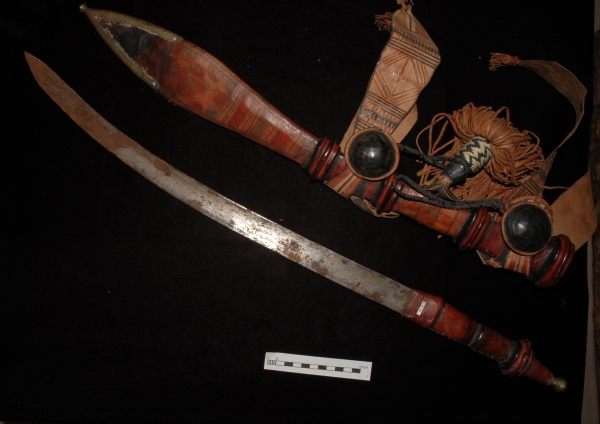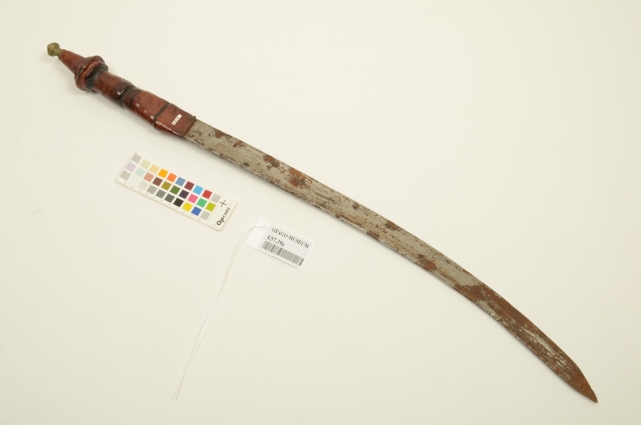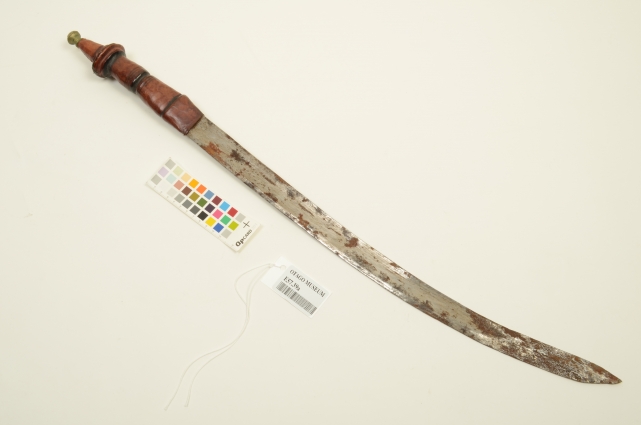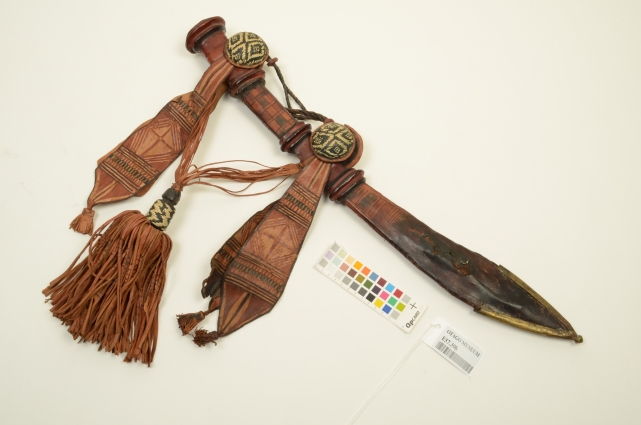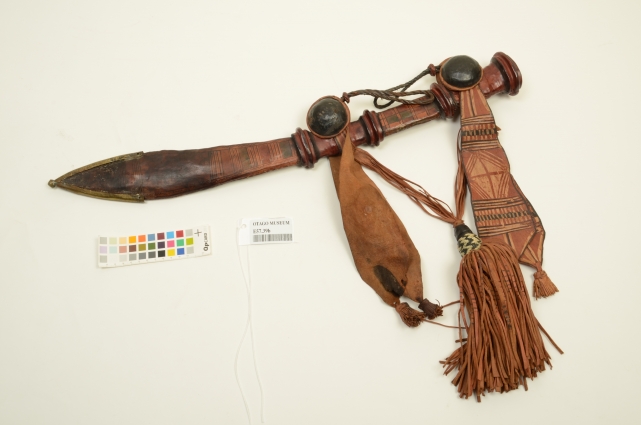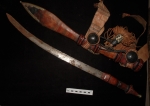Sword, Scabbard, E57.39
Physical Description
Sword with long curved iron blade and leather handle.
Elaborate leather scabbard with belt and tassels
Sword blade of iron(?) is slightly curved and hollow ground from hilt to near the tip. Blade appears to have been locally smithed. Handle is of tightly bound dark red leather (goat?) of one piece though sectioned into quarters starting from a flat section at the base, and becoming progressively more round as it approaches the top or end of hilt. This final rounded quarter is of 3 cylindrical discs ending in a cone and topped with a round brass knob.The handle comprises approximately a quarter length of the sword. The leather -as a single piece - is tightly wrapped and sewn with a leather cord along the cutting edge axis to the top of the handle. Handle - with the exception of its shape - is relatively little decorated except for several parallel lines of black dye running the circumference of the handle. Likely the handle shape is of some wood/bamboo(?) frame underlying the tightly bound leather. Over all appearance is of a well made item, likely used, and in good condition. Blade has not been sharpened. NOTE: Active rust on many parts of blade. Remnants of cockroach egg case on underside of leather knurl of handle at intersection of the 3rd & 4th quarter.
SCABBARD = Mainly of leather and slightly curved to accommodate sword blade of same (E57.38). Scabbard very elaborate - tassels, flaps, braided cords, weaving on large buttons, etc. Main body of scabbard is covered in single sheet of leather which is tightly wrapped around frame and sewn with animal sinew(?) along full length of scabbard (sharp blade edge) at least to upper part of scabbard and likely to the very upper edge. (The top 1/6 of scabbard is covered with a second piece of dark red leather under which the 1st layer of leather likely extends.) The bottom first 1/6 of scabbard is decorated with a series of 1/3 of scabbard is decorated with a series of black dyed parallel lines. The second 1/6 of scabbard is decorated with a grouping of concentric and overlapping circles - the enclosed areas being dyed either green or red. (NOTE: tiny holes in the centre of each circle suggest that a mechanical means e.g. compass/protractor, might have been used to assure accurate circles. Also thin incised lines crossing at midpoint of central circle suggest process of laying out the pattern.) The 3rd 1/6 of scabbard is decorated with a series of parallel black lines with 4 sections of alternating red and green dye. The 4th 1/6 is formed of another sheet of dark red leather wrapped tightly over the bottom layer. This section is comprised of a series of ridges running the circumference of the scabbard. the next 1/6, i.e. the 5th 1/6 is again the same base layer of leather but now decorated with a series of horizontal and vertical dyed black lines forming a series of rectangles. The rectangles are alternately coloured natural, red, and green. The top 1/6 is again a second piece of tightly bound red leather sewn along the edge and comprising a series of ridges of different heights running the circumference of the scabbard. The leather at the top overlaps the edge and runs well down into the opening into which the iron blade runs. The bottom 1/6 of scabbard is edged with a sheet of lightly decorated brass which terminates at the very base in a brass cone. This brass edging appears to be fastened with short metal tacks along its length. (NOTE: tacks have corroded to the extent of leaving the brass edging unfastened - though still attached/clinging to leather.) (NOTE: Leather on both sides of scabbard in vicinity of brass edging is darkened and cracked. On one side leather has flaked off leaving exposed an apparent under-wrap of plant(?) fibre not unlike burlap.) At the 4th 1/6 a narrow leather belt is loosely wrapped around the scabbard and brought together with a second narrower wrapping of leather. The belt continues as a series of parallel narrow strips and then joins a belt of same construction which extends from around the middle of the top 1/6 . At this join a dark leather bell shape tightly binds these strands into one at its top. From its base extends dozens of narrow strips of leather forming a tassel. Where each of the two belts are loosely bound to the main body of the scabbard there are two large concave shaped leather buttons of dark leather edged in light coloured leather. Back to back these pairs of buttons are each connected to a strap of twisted dark leather which both with each end fastened between each pair, i.e. one strap for each pair of buttons. While one button of each pair is of plain dark leather the other button has a pattern of light coloured plant fibre woven into the face amongst cuts in the leather. ALSO running from each pair of buttons are two lengths (from each pair of buttons) of wide leather flaps. One side of each flap has a series of parallel and intersecting lines cut into the leather and dyed either red or black - along with the natural coloured stripes - forming a patterns of geometrical shapes.. The end of each flap narrows and is tied off with a small tassel of narrow leather strips. The overall appearance is of a well crafted item, used and in good condition. (NOTE: Scabbards E57.38 and E57.39 are essentially incidental in decoration and appearance. However, E57.39 has the addition of squiggly ink lines along the edged of the lower part of scabbard, on both sides. (NOTE: Scabbard appears to have no identification number. Match with correct sword was made on basis of relative lengths.)
Elaborate leather scabbard with belt and tassels
Sword blade of iron(?) is slightly curved and hollow ground from hilt to near the tip. Blade appears to have been locally smithed. Handle is of tightly bound dark red leather (goat?) of one piece though sectioned into quarters starting from a flat section at the base, and becoming progressively more round as it approaches the top or end of hilt. This final rounded quarter is of 3 cylindrical discs ending in a cone and topped with a round brass knob.The handle comprises approximately a quarter length of the sword. The leather -as a single piece - is tightly wrapped and sewn with a leather cord along the cutting edge axis to the top of the handle. Handle - with the exception of its shape - is relatively little decorated except for several parallel lines of black dye running the circumference of the handle. Likely the handle shape is of some wood/bamboo(?) frame underlying the tightly bound leather. Over all appearance is of a well made item, likely used, and in good condition. Blade has not been sharpened. NOTE: Active rust on many parts of blade. Remnants of cockroach egg case on underside of leather knurl of handle at intersection of the 3rd & 4th quarter.
SCABBARD = Mainly of leather and slightly curved to accommodate sword blade of same (E57.38). Scabbard very elaborate - tassels, flaps, braided cords, weaving on large buttons, etc. Main body of scabbard is covered in single sheet of leather which is tightly wrapped around frame and sewn with animal sinew(?) along full length of scabbard (sharp blade edge) at least to upper part of scabbard and likely to the very upper edge. (The top 1/6 of scabbard is covered with a second piece of dark red leather under which the 1st layer of leather likely extends.) The bottom first 1/6 of scabbard is decorated with a series of 1/3 of scabbard is decorated with a series of black dyed parallel lines. The second 1/6 of scabbard is decorated with a grouping of concentric and overlapping circles - the enclosed areas being dyed either green or red. (NOTE: tiny holes in the centre of each circle suggest that a mechanical means e.g. compass/protractor, might have been used to assure accurate circles. Also thin incised lines crossing at midpoint of central circle suggest process of laying out the pattern.) The 3rd 1/6 of scabbard is decorated with a series of parallel black lines with 4 sections of alternating red and green dye. The 4th 1/6 is formed of another sheet of dark red leather wrapped tightly over the bottom layer. This section is comprised of a series of ridges running the circumference of the scabbard. the next 1/6, i.e. the 5th 1/6 is again the same base layer of leather but now decorated with a series of horizontal and vertical dyed black lines forming a series of rectangles. The rectangles are alternately coloured natural, red, and green. The top 1/6 is again a second piece of tightly bound red leather sewn along the edge and comprising a series of ridges of different heights running the circumference of the scabbard. The leather at the top overlaps the edge and runs well down into the opening into which the iron blade runs. The bottom 1/6 of scabbard is edged with a sheet of lightly decorated brass which terminates at the very base in a brass cone. This brass edging appears to be fastened with short metal tacks along its length. (NOTE: tacks have corroded to the extent of leaving the brass edging unfastened - though still attached/clinging to leather.) (NOTE: Leather on both sides of scabbard in vicinity of brass edging is darkened and cracked. On one side leather has flaked off leaving exposed an apparent under-wrap of plant(?) fibre not unlike burlap.) At the 4th 1/6 a narrow leather belt is loosely wrapped around the scabbard and brought together with a second narrower wrapping of leather. The belt continues as a series of parallel narrow strips and then joins a belt of same construction which extends from around the middle of the top 1/6 . At this join a dark leather bell shape tightly binds these strands into one at its top. From its base extends dozens of narrow strips of leather forming a tassel. Where each of the two belts are loosely bound to the main body of the scabbard there are two large concave shaped leather buttons of dark leather edged in light coloured leather. Back to back these pairs of buttons are each connected to a strap of twisted dark leather which both with each end fastened between each pair, i.e. one strap for each pair of buttons. While one button of each pair is of plain dark leather the other button has a pattern of light coloured plant fibre woven into the face amongst cuts in the leather. ALSO running from each pair of buttons are two lengths (from each pair of buttons) of wide leather flaps. One side of each flap has a series of parallel and intersecting lines cut into the leather and dyed either red or black - along with the natural coloured stripes - forming a patterns of geometrical shapes.. The end of each flap narrows and is tied off with a small tassel of narrow leather strips. The overall appearance is of a well crafted item, used and in good condition. (NOTE: Scabbards E57.38 and E57.39 are essentially incidental in decoration and appearance. However, E57.39 has the addition of squiggly ink lines along the edged of the lower part of scabbard, on both sides. (NOTE: Scabbard appears to have no identification number. Match with correct sword was made on basis of relative lengths.)
Research Notes
SWORD = Iron(?) (blade of sword, brass (cap of hilt of sword, leather (goat?) covering of handle of sword. Likely there is a frame of wood/bamboo(?) beneath the leather of handle. SCABBARD = Leather (goat), brass, (covering for pointed end of scabbard), animal sinew(?) (cord for binding/sewing two edges of leather along full length of scabbard), light coloured plant fibre (bamboo/grass?) used in decorative pattern on one of 3 rosettes and also in the pattern on the circumference of the handle for the leather tassels. It is likely that a frame of wood/bamboo gives form and strength to the scabbard - underlying the leather covering.
Though there is some suggestion of tourist Art' this sword and scabbard are likely to have been used in ceremonial occasions, e.g. for horsemen to carry in the 'Durbars' (celebrations) conducted by the Hausa of Northern Nigeria. Patina on handle of sword and on scabbard would suggest that these items have been used. NOTE: Sword has not been sharpened.
Sword blade of iron(?) is slightly curved and 'hollow ground' from hilt to near the tip. Blade appears to have been locally smithed. Handle is of tightly bound dark red leather (goat?) of one piece though sectioned into quarters starting from a flat section at the base, and becoming progressively more round as it approaches the top or end of hilt. This final rounded quarter is of 3 cylindrical discs ending in a cone and topped with a round brass knob.The handle comprises approximately a quarter length of the sword. The leather -as a single piece - is tightly wrapped and sewn with a leather cord along the cutting edge axis to the top of the handle. Handle - with the exception of its shape - is relatively little decorated except for several parallel lines of black dye running the circumference of the handle. Likely the handle shape is of some wood/bamboo(?) frame underlying the tightly bound leather. Over all appearance is of a well made item, likely used, and in good condition. Blade has not been sharpened. NOTE: Active rust on many parts of blade. Remnants of cockroach egg case on underside of leather knurl of handle at intersection of the '3rd & 4th quarter'.
SCABBARD = Mainly of leather and slightly curved to accommodate sword blade of same (E57.38). Scabbard very elaborate - tassels, flaps, braided cords, weaving on large buttons, etc. Main body of scabbard is covered in single sheet of leather which is tightly wrapped around frame and sewn with animal sinew(?) along full length of scabbard (sharp blade edge) at least to upper part of scabbard and likely to the very upper edge. (The top 1/6 of scabbard is covered with a second piece of dark red leather under which the 1st layer of leather likely extends.) The bottom first 1/6 of scabbard is decorated with a series of 1/3 of scabbard is decorated with a series of black dyed parallel lines. The second 1/6 of scabbard is decorated with a grouping of concentric and overlapping circles - the enclosed areas being dyed either green or red. (NOTE: tiny holes in the centre of each circle suggest that a mechanical means e.g. compass/protractor, might have been used to assure accurate circles. Also thin incised lines crossing at midpoint of central circle suggest process of laying out the pattern.) The 3rd 1/6 of scabbard is decorated with a series of parallel black lines with 4 sections of alternating red and green dye. The 4th 1/6 is formed of another sheet of dark red leather wrapped tightly over the bottom layer. This section is comprised of a series of ridges running the circumference of the scabbard. the next 1/6, i.e. the 5th 1/6 is again the same base layer of leather but now decorated with a series of horizontal and vertical dyed black lines forming a series of rectangles. The rectangles are alternately coloured natural, red, and green. The top 1/6 is again a second piece of tightly bound red leather sewn along the edge and comprising a series of ridges of different heights running the circumference of the scabbard. The leather at the top overlaps the edge and runs well down into the opening into which the iron blade runs. The bottom 1/6 of scabbard is edged with a sheet of lightly decorated brass which terminates at the very base in a brass cone. This brass edging appears to be fastened with short metal tacks along its length. (NOTE: tacks have corroded to the extent of leaving the brass edging unfastened - though still attached/clinging to leather.) (NOTE: Leather on both sides of scabbard in vicinity of brass edging is darkened and cracked. On one side leather has flaked off leaving exposed an apparent underwrap of plant(?) fibre not unlike burlap.) At the '4th' 1/6 a narrow leather belt is loosely wrapped around the scabbard and brought together with a second narrower wrapping of leather. The belt continues as a series of parallel narrow strips and then joins a belt of same construction which extends from around the middle of the top '1/6' . At this join a dark leather bell shape tightly binds these strands into one at its top. From its base extends dozens of narrow strips of leather forming a tassel. Where each of the two belts are loosely bound to the main body of the scabbard there are two large concave shaped leather buttons of dark leather edged in light coloured leather. Back to back these pairs of buttons are each connected to a strap of twisted dark leather which both with each end fastened between each pair, i.e. one strap for each pair of buttons. While one button of each pair is of plain dark leather the other button has a pattern of light coloured plant fibre woven into the face amongst cuts in the leather. ALSO running from each pair of buttons are two lengths (from each pair of buttons) of wide leather flaps. One side of each flap has a series of parallel and intersecting lines cut into the leather and dyed either red or black - along with the natural coloured stripes - forming a patterns of geometrical shapes.. The end of each flap narrows and is tied off with a small tassel of narrow leather strips. The overall appearance is of a well crafted item, used and in good condition. (NOTE: Scabbards E57.38 and E57.39 are essentially incidental in decoration and appearance. However, E57.39 has the addition of squiggly ink lines along the edged of the lower part of scabbard, on both sides. (NOTE: Scabbard appears to have no identification number. Match with correct sword was made on basis of relative lengths.)
? (late 19th early 20th century?)
Length of sword = approx. 791mm. Length of handle of sword = approx. 220mm. Length of leather scabbard = approx. 653mm. —Joel A Vanderburg
Though there is some suggestion of tourist Art' this sword and scabbard are likely to have been used in ceremonial occasions, e.g. for horsemen to carry in the 'Durbars' (celebrations) conducted by the Hausa of Northern Nigeria. Patina on handle of sword and on scabbard would suggest that these items have been used. NOTE: Sword has not been sharpened.
Sword blade of iron(?) is slightly curved and 'hollow ground' from hilt to near the tip. Blade appears to have been locally smithed. Handle is of tightly bound dark red leather (goat?) of one piece though sectioned into quarters starting from a flat section at the base, and becoming progressively more round as it approaches the top or end of hilt. This final rounded quarter is of 3 cylindrical discs ending in a cone and topped with a round brass knob.The handle comprises approximately a quarter length of the sword. The leather -as a single piece - is tightly wrapped and sewn with a leather cord along the cutting edge axis to the top of the handle. Handle - with the exception of its shape - is relatively little decorated except for several parallel lines of black dye running the circumference of the handle. Likely the handle shape is of some wood/bamboo(?) frame underlying the tightly bound leather. Over all appearance is of a well made item, likely used, and in good condition. Blade has not been sharpened. NOTE: Active rust on many parts of blade. Remnants of cockroach egg case on underside of leather knurl of handle at intersection of the '3rd & 4th quarter'.
SCABBARD = Mainly of leather and slightly curved to accommodate sword blade of same (E57.38). Scabbard very elaborate - tassels, flaps, braided cords, weaving on large buttons, etc. Main body of scabbard is covered in single sheet of leather which is tightly wrapped around frame and sewn with animal sinew(?) along full length of scabbard (sharp blade edge) at least to upper part of scabbard and likely to the very upper edge. (The top 1/6 of scabbard is covered with a second piece of dark red leather under which the 1st layer of leather likely extends.) The bottom first 1/6 of scabbard is decorated with a series of 1/3 of scabbard is decorated with a series of black dyed parallel lines. The second 1/6 of scabbard is decorated with a grouping of concentric and overlapping circles - the enclosed areas being dyed either green or red. (NOTE: tiny holes in the centre of each circle suggest that a mechanical means e.g. compass/protractor, might have been used to assure accurate circles. Also thin incised lines crossing at midpoint of central circle suggest process of laying out the pattern.) The 3rd 1/6 of scabbard is decorated with a series of parallel black lines with 4 sections of alternating red and green dye. The 4th 1/6 is formed of another sheet of dark red leather wrapped tightly over the bottom layer. This section is comprised of a series of ridges running the circumference of the scabbard. the next 1/6, i.e. the 5th 1/6 is again the same base layer of leather but now decorated with a series of horizontal and vertical dyed black lines forming a series of rectangles. The rectangles are alternately coloured natural, red, and green. The top 1/6 is again a second piece of tightly bound red leather sewn along the edge and comprising a series of ridges of different heights running the circumference of the scabbard. The leather at the top overlaps the edge and runs well down into the opening into which the iron blade runs. The bottom 1/6 of scabbard is edged with a sheet of lightly decorated brass which terminates at the very base in a brass cone. This brass edging appears to be fastened with short metal tacks along its length. (NOTE: tacks have corroded to the extent of leaving the brass edging unfastened - though still attached/clinging to leather.) (NOTE: Leather on both sides of scabbard in vicinity of brass edging is darkened and cracked. On one side leather has flaked off leaving exposed an apparent underwrap of plant(?) fibre not unlike burlap.) At the '4th' 1/6 a narrow leather belt is loosely wrapped around the scabbard and brought together with a second narrower wrapping of leather. The belt continues as a series of parallel narrow strips and then joins a belt of same construction which extends from around the middle of the top '1/6' . At this join a dark leather bell shape tightly binds these strands into one at its top. From its base extends dozens of narrow strips of leather forming a tassel. Where each of the two belts are loosely bound to the main body of the scabbard there are two large concave shaped leather buttons of dark leather edged in light coloured leather. Back to back these pairs of buttons are each connected to a strap of twisted dark leather which both with each end fastened between each pair, i.e. one strap for each pair of buttons. While one button of each pair is of plain dark leather the other button has a pattern of light coloured plant fibre woven into the face amongst cuts in the leather. ALSO running from each pair of buttons are two lengths (from each pair of buttons) of wide leather flaps. One side of each flap has a series of parallel and intersecting lines cut into the leather and dyed either red or black - along with the natural coloured stripes - forming a patterns of geometrical shapes.. The end of each flap narrows and is tied off with a small tassel of narrow leather strips. The overall appearance is of a well crafted item, used and in good condition. (NOTE: Scabbards E57.38 and E57.39 are essentially incidental in decoration and appearance. However, E57.39 has the addition of squiggly ink lines along the edged of the lower part of scabbard, on both sides. (NOTE: Scabbard appears to have no identification number. Match with correct sword was made on basis of relative lengths.)
? (late 19th early 20th century?)
Length of sword = approx. 791mm. Length of handle of sword = approx. 220mm. Length of leather scabbard = approx. 653mm. —Joel A Vanderburg
Africa Collection File: "Pres. F.F. A. Ulrich from the estate of his late brother G.A.C. Ulrich B.Sc., AOSM (3rd son of the late Prof Ulrich, one time curator of O.M.) 1898-1912 mining in Tasmania, Australia & NZ; 1913-14 Gold Coast; [GHANA] 1919-24 Asante goldfields; Gold Mining Co. Ltd.; 1927-28general prospecting in Nigeria, Illorin Provin& Mica (?) Died 1956, NZ " —Sarah Brodie
Provenance
Collected by: G Ulrich
West Africa
Measurements
Maximum dimensions (H x W x D) (a - Sword): 765 x 40 x 45mmMaximum dimensions (H x W x D) (b - Scabbard): 650 x 260 x 80mm
All Rights Reserved


